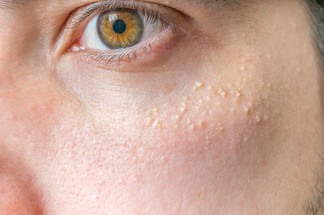Jan 22nd 2020
Q&A with Elina Fedotova: How to Get Rid of Milia
Elina was recently interviewed for Shape Magazine about milia. You can read the featured article, How to Get Rid of Milia, here.
Clogged pores are usually caused by excess oil, dirt, and bacteria becoming trapped inside a pore and creating a pimple or blackhead or whitehead; unlike milia, they're extractable and if you squeeze, all that gunk will come out of it. There may be oil trapped in milia as well (along with the keratin build-up), but it's trapped much deeper and covered by layers of dead skin, explains celebrity esthetician Elina Fedotova, founder of Elina Organics Spa and Skincare.
Q. What is milia?
A. Milia is an excessive oil deposit trapped inside of the pore before it has the chance to reach the top and oxidize by air and turn into a black head or get contaminated and becomes a blemish. Sometimes, milia is made out of a blend of bad bacteria, excessive skin sebum (skin oil) mixed with dead skin cells. Usually it feels hard when you touch it and very often it is impossible to extract without breaking the surface. I do not suggest that you do this at home and it should only be extracted by a professional.
Q. How does it differ from other types of clogged pores?
A. Each pore contains an oil gland which produces skin oil (sebum) which works as an emollient and helps to protect our skin surface from over drying. When our sebum gland makes too much oil it can fill the entire pore and expand it. On the top, that oil gets in contact with oxygen from the air, changes the color, and turns into a blackhead. Sometimes a widely open pore that is filled with oil could be contaminated by environmental pollutants, as well. Pores could be clogged by a different solvent and wax based emulcifiers from heavy skin care products, talcum, silicone, and other chemicals from conventional makeup. Even mineral based face powder sometimes can clog and accentuate the pores and make your face feel heavier. That is why I prefer makeup foundation based on crushed pearl because pearl powder contains beneficial essential nutrients which is important for skins health and does not clog the pores. The difference between clog pores and milia is that pores can be easily cleaned out with skin cleansers and scrubs or could be vacuumed out during the facial. However in the case of milia you can not vacuum or scrub it off because the oil in the milia is trapped deep inside and covered by layers of dead skin cells which need to be removed before you can extract it.
Q. What causes milia and what are the best ways to prevent them?
A. Certain people have a genetic predisposition to form milia. Usually these people have very dehydrated complexion and narrow pores which makes it hard for oil to exit and easier to be trapped inside. Milia usually forms and comes back in the same areas where people have overactive sebum glands. Another reason for milia formation is silicon based heavy skin concealers and foundations. They cover the skin with a thin film which traps the oil into the pores and produce a green house effect. This is why you often see milia under the eye area because many people use heavy concealers to cover up dark circles. Also, people who eat too much sugar, dairy or other animal proteins have a tendency to have more milia. The best way to prevent milia is too make sure you are staying hydrated and drink plenty of water or herbal tea. Use water based natural skin care products with less emollients (oils and butters) and more humectants (hyaluronic acid, aloe vera extract, snow mushroom extract, etc.). Avoid products with cosmetic silicone derivatives.
Q. Once you do have them, what are the best ways to get rid of them?
A. Stop using heavy skin care and makeup products, use a water based skin care regimen and exfoliate your skin regularly. Schedule a clinical facial to extract the milia by a professional. Use oil controlling serums daily in the areas where you have the tendency to form milia.

